None
Most users ever online was 387 on Tue Dec 05, 2023 7:35 pm
The newest registered user is Skylines3
Our users have posted a total of 47502 messages in 4941 subjects
| No user |
• The FREE hand reading services at the Modern Hand Reading Forum are being continued in 2019 with the assistance of Google adsense!

Learn how to read hands according the Modern Hand Reading paradigm & you can use this forum as your palm reading guide!
How to discriminate a simian crease from a Sydney line and a Suwon crease!
Modern Hand Reading Forum - Discover the language of your hands: palm reading & palmistry forum! :: III - MODERN HAND READING - Various systems for reading hands! :: IIIa - Modern Palmistry: general topics, questions :: IIIf - (Scientific) Multi-Perspective Palm Reading
Page 1 of 7 • 1, 2, 3, 4, 5, 6, 7 
 How to discriminate a simian crease from a Sydney line and a Suwon crease!
How to discriminate a simian crease from a Sydney line and a Suwon crease!

During the past months I have noticed that many people experience problems with discriminating a simian line from other unusual hand line types (such as the Sydney line, Suwon crease and the extended heart line).
In the following article I describe the essential characteristics of these lines, featured with a short historical review focussed on the significance of each of those lines in medical scientific perspective:
http://palmreadingperspectives.wordpress.com/2011/05/25/how-to-classify-the-palmar-lines-the-simian-line-sydney-line-the-suwon-crease/
I hope that the picture (above) + descriptions will become usefull to recognize the essential differences between these 4 fundamentally different variants of the 'transversal palmar creases' - which all relate to the COMBINATION of the heart line & the head line!
Your comments are welcome...!
PS. A high quality version of the picture is available HERE.
 Re: How to discriminate a simian crease from a Sydney line and a Suwon crease!
Re: How to discriminate a simian crease from a Sydney line and a Suwon crease!
Thanks for illustrating the variances of transverse palmar crease. But i find difficulty in discriminate the extended heart line with suwon crease and it would be helpful if you explain a bit about 'what does each of this variants infer in palmistry'? (especially suwon crease and extended heart line infers?)
sv-b- Posts : 615
Join date : 2010-10-20
 Re: How to discriminate a simian crease from a Sydney line and a Suwon crease!
Re: How to discriminate a simian crease from a Sydney line and a Suwon crease!
Hi Stalin,
Yes, I recognize the importance of your question (
 ):
):Regarding the difference between the 'extended heart line' and the 'Suwon crease'... the fundamental difference concerns that in the first there is just one (long) heart line + one normal head line involved, while in a Suwon crease the hand should display evidence of a fusion of two lines + one normal head line.
But one also has to be aware that many heart lines show a 'splitting'. And regarding the 'Suwon crease', one should understand here that any 'Suwon crease' may look (at first sight) like a 'splitting'.
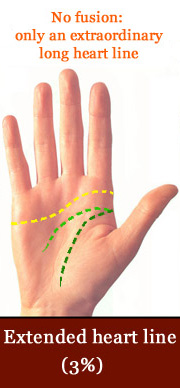
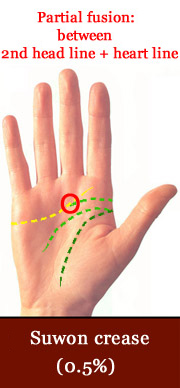
The following 2 tips should make you able to recognize the difference:
- Therefore it probably requires some experience in analysing the details of heart lines & head lines, in order to be able to discriminate a 'splitting' (where the 2 resulting lines typically look weaker than the first homogenous part) from a fusion of two lines.
- And regarding the second head line: one should also look for similarities with the other head line.
So, if you understand what I have just described... hopefully you will now be able to recognize the fundamental differences between both variants, which is a requirement to discriminate an 'extended heart line' from a 'Suwon crease'.
Have I answered your question?

 Re: How to discriminate a simian crease from a Sydney line and a Suwon crease!
Re: How to discriminate a simian crease from a Sydney line and a Suwon crease!

Pamelah- Posts : 181
Join date : 2010-08-27
Location : Silicon Valley, California
 Re: How to discriminate a simian crease from a Sydney line and a Suwon crease!
Re: How to discriminate a simian crease from a Sydney line and a Suwon crease!

Pamelah - I understand what you are asking. Re the Suwon crease we only have that one scientific paper to look at - as discussed here
https://www.modernhandreadingforum.com/t199-report-korean-researchers-discovered-the-suwon-crease-only-observed-in-males
But that gives us no interpretation to use as handreaders! In practical handreading, like you I would tell clients about the forked heartline - in your terms the Hermit & Romantic Idealist type of lines. By the way Pamelah, thanks for your heartlines blog - I have included a link to it in my updated handreading course, and talk about your useful terminology in the heartline lesson.

 Re: How to discriminate a simian crease from a Sydney line and a Suwon crease!
Re: How to discriminate a simian crease from a Sydney line and a Suwon crease!
Lynn wrote:Martijn -
Pamelah - I understand what you are asking. Re the Suwon crease we only have that one scientific paper to look at - as discussed here
https://www.modernhandreadingforum.com/t199-report-korean-researchers-discovered-the-suwon-crease-only-observed-in-males
thanks clarifying Lynn. I think I'll stick with the heart line forked conversation since there isn't a conversation about what it means. It has to be similar to that anyway!
But that gives us no interpretation to use as handreaders! In practical handreading, like you I would tell clients about the forked heartline - in your terms the Hermit & Romantic Idealist type of lines. By the way Pamelah, thanks for your heartlines blog - I
have included a link to it in my updated handreading course, and talk about your useful terminology in the heartline lesson.
Wow! Thanks Lynn. I'm glad it's so useful. That was my desire!

Pamelah- Posts : 181
Join date : 2010-08-27
Location : Silicon Valley, California
 Re: How to discriminate a simian crease from a Sydney line and a Suwon crease!
Re: How to discriminate a simian crease from a Sydney line and a Suwon crease!
Pamelah wrote:Martijn, how is the Suwon line different from a split heart line that has the split under Saturn, with an extension to Jupiter? If I saw that I would call this a split heart line with Hermt and Romantic Idealist.
Hello Pamelah!!

I have described a few clues in my response to Stalin, but I can add a few elements. The essential between a Suwon crease and a 'split heart line' is found in the 'structure' of the line:
- Only if the structure of the line under discussion is likewise strong as the lower head line AND if the line is at least equal (or stronger) than the radial part of the heart line... then it meets all requirements to be called a Suwon crease.
- However, if the line has a likewise structure as seen in the upper part of the heart line AND when it is clearly weaker than the lower head line... then it can simply be described as a 'splitting heart line' - and if the lower branch of the splitting heart line is reaching out to the radial side of the palm, then one can describe it as an 'extended heart line variant' that is featured with a 'splitting'.
So this really requires a consideration of the structure of both the other heart line parts + the structure of the head line.
Pamelah, have I been able to answer your question?

 Re: How to discriminate a simian crease from a Sydney line and a Suwon crease!
Re: How to discriminate a simian crease from a Sydney line and a Suwon crease!
Lynn...Lynn wrote:
Martijn -

 Re: How to discriminate a simian crease from a Sydney line and a Suwon crease!
Re: How to discriminate a simian crease from a Sydney line and a Suwon crease!

Pamelah- Posts : 181
Join date : 2010-08-27
Location : Silicon Valley, California
 Re: How to discriminate a simian crease from a Sydney line and a Suwon crease!
Re: How to discriminate a simian crease from a Sydney line and a Suwon crease!
Also Martijin what about the Hal 600 or is it 900. Thanks,
Jeanette.
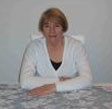
jeanette- Posts : 568
Join date : 2010-07-27
Location : scotland
 Re: How to discriminate a simian crease from a Sydney line and a Suwon crease!
Re: How to discriminate a simian crease from a Sydney line and a Suwon crease!
jeanette wrote:I think I understand this Suwon Crease now. It must have a second head line, separate from the first, not joined, which joins the heart line. If it wasn't for this second head line appearing it would be a straightforward hand. ....
Hi Jeanette,
Yes, sounds like my new picture was helpfull for you to understand the essential element: you've described it in your own words very well!

 Re: How to discriminate a simian crease from a Sydney line and a Suwon crease!
Re: How to discriminate a simian crease from a Sydney line and a Suwon crease!
But what is the Hal 600 or 900.
Jeanette.

jeanette- Posts : 568
Join date : 2010-07-27
Location : scotland
 Re: How to discriminate a simian crease from a Sydney line and a Suwon crease!
Re: How to discriminate a simian crease from a Sydney line and a Suwon crease!
Pamelah wrote:Yes, Martijn. You answered it and as Lynn pointed out, what does it mean?
Hi Pamelah,
Sorry... I think your question regarding the meaning is a little bit too early: because we can only speculate about this, or present 'theoretical' interpretations.
So far I have the impression that this line variant could be found more often in the hands of 'intelligent Beta-oriented males' with an introvert personality or a not very social oriented nature.
I also think that this line variant has a more positive nature than the simian line & the Sydney line (which both are known in medical science as a 'minor physical anomaly').
But these are just a few associations based on the populations that I have studied so far.

 Re: How to discriminate a simian crease from a Sydney line and a Suwon crease!
Re: How to discriminate a simian crease from a Sydney line and a Suwon crease!
jeanette wrote:Thanks Martijin,
But what is the Hal 600 or 900.
Jeanette.
Hi Jeanette,
You probably are reffering to Richard Unger's 'Hal 9000 head line', see:
http://www.handresearch.com/news/gift-markings-in-your-hand.htm
The 'Hal 9000 head line' is a very long head line which ends at a location below the center of the
So... the 'Hal 9000 head line' is a little bit SHORTER than the Sydney line!
Does this make sense now as well?

Last edited by Martijn (admin) on Thu May 26, 2011 10:25 pm; edited 1 time in total
 Re: How to discriminate a simian crease from a Sydney line and a Suwon crease!
Re: How to discriminate a simian crease from a Sydney line and a Suwon crease!
Martijn (admin) wrote:
The 'Hal 9000 head line' is a very long head line which ends at a location below the center of the middle finger...[/color]
Martijn, that should be little finger.
 Re: How to discriminate a simian crease from a Sydney line and a Suwon crease!
Re: How to discriminate a simian crease from a Sydney line and a Suwon crease!
Thanks Lynn, I have corrected the error.
 Re: How to discriminate a simian crease from a Sydney line and a Suwon crease!
Re: How to discriminate a simian crease from a Sydney line and a Suwon crease!
jeanette wrote:I think I understand this Suwon Crease now. It must have a second head line, separate from the first, not joined, which joins the heart line. If it wasn't for this second head line appearing it would be a straightforward hand. As for what it means in palmistry interpretation Patti gave a long and interesting theory and thought it was getting to grip with things.
Also Martijin what about the Hal 600 or is it 900. Thanks,
Jeanette.
Hi Jeanette,
The Korean's wrote in their report that they believed the major creases being pulled to the radial side of the palm was related to strong hand grip. Hand grip is discussed in "The Psychobiology of the Hand" by Kevin J. Connolly. What I wrote was based on, or influenced by, these references.
As far as relating it to behavior - there must be a reason we use terms like "getting a grip".
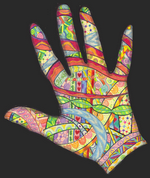
Patti- Posts : 3912
Join date : 2010-07-24
 Re: How to discriminate a simian crease from a Sydney line and a Suwon crease!
Re: How to discriminate a simian crease from a Sydney line and a Suwon crease!
Martijn (admin) wrote:
During the past months I have noticed that many people experience problems with discriminating a simian line from other unusual hand line types (such as the Sydney line, Suwon crease and the extended heart line).
In the following article I describe the essential characteristics of these lines, featured with a short historical review focussed on the significance of each of those lines in medical scientific perspective:
http://palmreadingperspectives.wordpress.com/2011/05/25/how-to-classify-the-palmar-lines-the-simian-line-sydney-line-the-suwon-crease/
I hope that the picture (above) + descriptions will become usefull to recognize the essential differences between these 4 fundamentally different variants of the 'transversal palmar creases' - which all relate to the COMBINATION of the heart line & the head line!
Your comments are welcome...!
PS. A high quality version of the picture is available HERE.
Hi Martijn,
I know, you know, that I think that some extended heart lines may be variants of the Suwon crease. This is because I think the heart line should not be located at the radial edge of the palm.
I find this quote from Schaumann & Alter "Dermatoglyphics in Medical Disorders"
describing a 'normal' heart line, or distal transverse crease, supportive of that view:
"The distal transverse crease is located between the proximal crease and the heads of the underlying metacarpal bones. Starting ordinarily in the space between the index and middle fingers, the crease curves gently proximally, ending on the ulnar edge of the palm."
Also, on page 109, Fig. 5.5 illustrates variations of the simian or single transverse crease. Example A and E both have what they call shortened proximal transverse creases with lengthened distal transverse creases extending the width of the palm. In my opinion, when and if the Korean's develop a list of variants of the Suwon, examples A & E will be variants. These examples can clearly be described as II + III with Accessory II. The Koreans have defined the creases that transverse the entire palm as II + III.
Last edited by Patti on Fri May 27, 2011 5:31 am; edited 1 time in total

Patti- Posts : 3912
Join date : 2010-07-24
 Re: How to discriminate a simian crease from a Sydney line and a Suwon crease!
Re: How to discriminate a simian crease from a Sydney line and a Suwon crease!
Notice how Number 10 with its extended transversing distal crease follows Number 9 with its extended transversing proximal transverse crease. This is how I see the Sydney and the Suwon as 'cousins'. Number 9 is II + III with Accessory III and Number 10 is II + III with Accessory II.
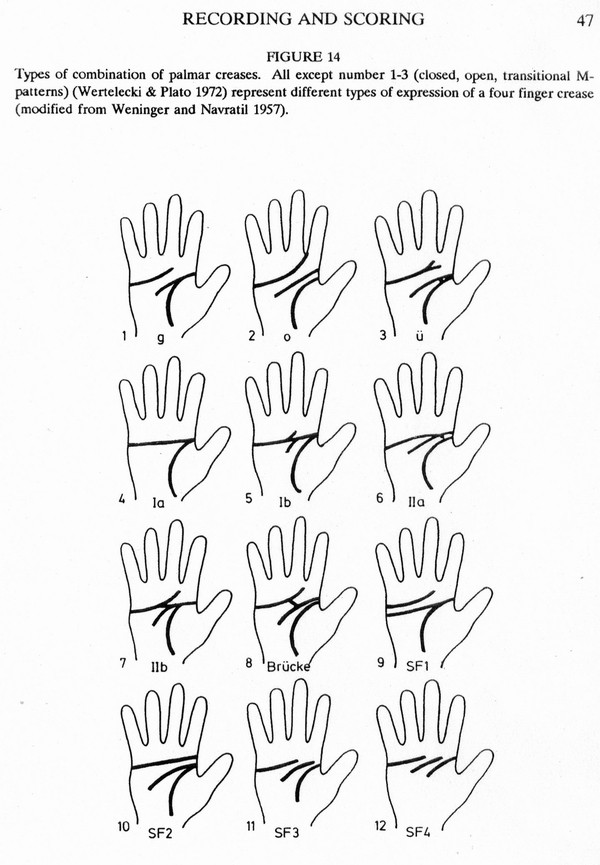
Numbers 1 - 3 show the normal distal transverse creases.

Patti- Posts : 3912
Join date : 2010-07-24
 Re: How to discriminate a simian crease from a Sydney line and a Suwon crease!
Re: How to discriminate a simian crease from a Sydney line and a Suwon crease!
Jeanette.

jeanette- Posts : 568
Join date : 2010-07-27
Location : scotland
 Re: How to discriminate a simian crease from a Sydney line and a Suwon crease!
Re: How to discriminate a simian crease from a Sydney line and a Suwon crease!
Thanks for your reply. I think, due to what Martijin, has theorised, this could also mean getting a grip of thoughts, getting the mind balanced and thinking rationally. Now that I have a better undertstanding of it I do not associate it, at all, with the Simian line or extended heart line. I believe it to be a double independant headline but it joins the heart line. Maybe there are two forces operating. Two levels of thinking..
Jeanette.

jeanette- Posts : 568
Join date : 2010-07-27
Location : scotland
 Re: How to discriminate a simian crease from a Sydney line and a Suwon crease!
Re: How to discriminate a simian crease from a Sydney line and a Suwon crease!
jeanette wrote:In one of the latest posts it was said that the Sydney line was believed to have to cross the whole palm but now it is accepted that it can end at the middle of the little finger. So does that now mean the Hal 9000 is obsolete and is a Sydney line. Thanks,
Jeanette.
No Jeanette.
What you should know is that Patti only refered how the Sydney line was originally defined in the work of S.G. Purvis-Smith (1968) - where it did not require to cross the full palm.
But afterwards it was never defined that way again.
(So I think you've misread Patti's words, but maybe she did not explain properly what she meant to described)
 Re: How to discriminate a simian crease from a Sydney line and a Suwon crease!
Re: How to discriminate a simian crease from a Sydney line and a Suwon crease!
Patti wrote:
Hi Martijn,
I know, you know, that I think that some extended heart lines may be variants of the Suwon crease. This is because I think the heart line should not be located at the radial edge of the palm.
I find this quote from Schaumann & Alter "Dermatoglyphics in Medical Disorders"
describing a 'normal' heart line, or distal transverse crease, supportive of that view:
"The distal transverse crease is located between the proximal crease and the heads of the underlying metacarpal bones. Starting ordinarily in the space between the index and middle fingers, the crease curves gently proximally, ending on the ulnar edge of the palm."
Also, on page 109, Fig. 5.5 illustrates variations of the simian or single transverse crease. Example A and E both have what they call shortened proximal transverse creases with lengthened distal transverse creases extending the width of the palm. In my opinion, when and if the Korean's develop a list of variants of the Suwon, examples A & E will be variants. These examples can clearly be described as II + III with Accessory II. The Koreans have defined the creases that transverse the entire palm as II + III.
Patti.... sorry, but I don't see how the quote supports your view. The word 'ordinarily' clearly suggests that the quote only describes where a heart line typically starts; but there are for sure many other locations where it can start.
And by the way, the comment about example A and E in figure 5.5... directly refers to the work of Leiber, while Schaumann & Alter only summarize some elements from his work - but Leiber's work origins from 1960 when the Sydney line was not yet even identified.
Just like in our fingerprints discussions, it is important here to notice who writes what ... and when!
Anyway, I think your opinion about those variants (as representing a Suwon crease) is completely unlikely: simply because those variants (A and E) clearly refer to the presence of an INCOMPLETE head line (they call it a 'shortened proximal crease').
While the concept of the Suwon crease clearly refers to the presence of a COMPLETE (accessory) head line.
Sorry Patti, I can only conclude that in your speculations you are ignoring some very obvious details in these materials - because your ideas do not acknowledge the essential difference between a COMPLETE head line and an INCOMPLETE head line.
 Re: How to discriminate a simian crease from a Sydney line and a Suwon crease!
Re: How to discriminate a simian crease from a Sydney line and a Suwon crease!
I expected your response, of course.
But, I do respectfully disagree.


Patti- Posts : 3912
Join date : 2010-07-24
 Re: How to discriminate a simian crease from a Sydney line and a Suwon crease!
Re: How to discriminate a simian crease from a Sydney line and a Suwon crease!
Patti wrote:Hi Martijn,
I expected your response, of course.
But, I do respectfully disagree.

Page 1 of 7 • 1, 2, 3, 4, 5, 6, 7 
 Similar topics
Similar topics» The Sydney line & simian crease are like 'fraternal twins'!
» Samudrik palmistry sign in hand and Sydney line in right hand and suwon crease in left hand
» A simian crease poll among parents of babies with Down syndrome!
» VII - REPORT: Korean researchers discovered the 'Suwon crease', only observed in males!
Modern Hand Reading Forum - Discover the language of your hands: palm reading & palmistry forum! :: III - MODERN HAND READING - Various systems for reading hands! :: IIIa - Modern Palmistry: general topics, questions :: IIIf - (Scientific) Multi-Perspective Palm Reading






» Teacher square on my Jupiter mount
» Handreading International Conference 2024
» Can anyone read it for me?
» Are there any signs in the hands that you are a twin flame?
» Square on Marriage line
» Cross in mount Jupiter
» clinodactyly: top phalanges bending towards Mercury finger
» Can anybody please read this hand
» Nisha Ghai
» Absolutely non-sense career till now
» Fate Destiny Line -
» VIII - Palmistry books TOP 100 - listed by 'Amazon Sales Rank'!
» Stewart Culin - Palmistry in China and Japan
» Herbert Giles - Palmistry in China